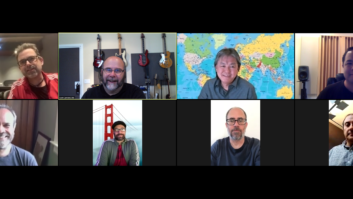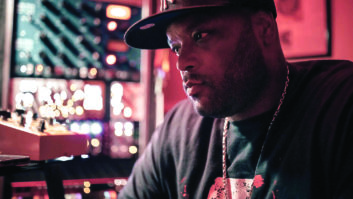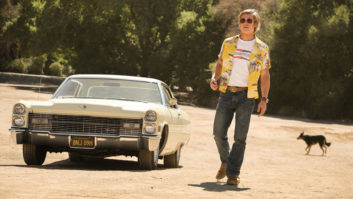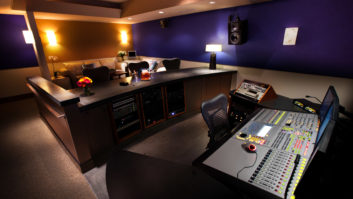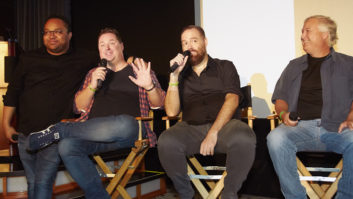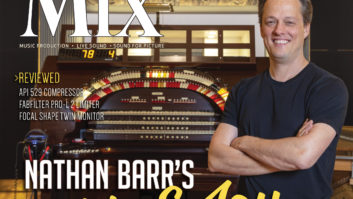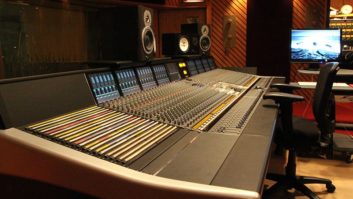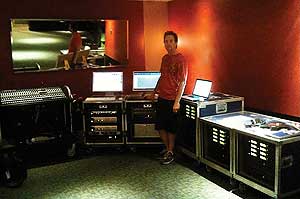
Working on sound for a “cooking challenge” in Montreal.
Sound mixer and recordist Michael Alexander, CAS provided us with this inside look at the day-to-day challenges of working on location for reality television. This article previously appeared in CAS Quarterly.
I’m typing this on a break aboard a Canadian frigate in Nova Scotia. The cast of the reality show I’m working on is preparing to do a challenge inside a big metal ship that’s not RF friendly in the least. Imagine thick steel doors and the cast running up and down different decks. Later today, one of the challenges has the cast entering an emergency repair training room where the military practices fixing pipes and patching up holes in the hull (mimicking what would happen if an enemy torpedo struck). Water slowly fills the room and blasts out of the wall so hard that during the rehearsal, the waterproof Countryman B6s blew clean off the stand-ins. I ended up planting them out of sight, which was probably what I should have done in the first place. Work and learn, right? At least the mics were rentals.

The Elora Gorge in Ontario, Canada, where Alexander recorded reality show contestants riding a Tyrolean traverse.
The one thing you can count on in every reality/unscripted television show (and I’ve done a lot of them): It’s seldom boring for the sound department. Of course, “reality” television is created in the field as things are happening, there’s no firm script (though—surprise, surprise—sometimes there is a sort-of script) and the shooting schedule is created late the night before. I’ve found that it’s essential to be as prepared and organized as possible. My experience in reality television has varied a lot. Sometimes there is a full control room build and I’m working on a stage. This time out, though, I’m doing a reality/challenge-based show that’s a cross between Fear Factor and Survivor. (Okay, what reality show isn’t, I guess.)
Here’s a sample of a typical Day 1: I tracked 20 kids and a couple of guests on a Tyrolean traverse (sort of like a zip line) crossing the Elora Gorge in Ontario. When they hit the ground on the other side of the tree line, they ran 100 yards to the finish line. We had to contend with the gushing Grand River and the limestone cliffs, but also, when hiding mics, we had to deal with harnesses and other climbing regalia. Of course, the first episode always has the most cast members and setup time is usually tight. I discovered at the scout session that I couldn’t set up my rig on the other side of the gorge and have the cast run to me, so I had to figure out my positioning so that I was close enough to capture the send-off but I wouldn’t have the cast literally run out of my RF field once they reached the other side. I did have a setup/test day, so I felt pretty confident. Still, it’s always challenging to throw RF cleanly that far, and it’s more critical this time because there are no ENG mixers on this show (yup, the budgets for reality television have shrunk, too)—just two local A2s and me. Being that this is a competition-based show, the dialog has to be captured cleanly during the challenge; there’s no do-over. We have a Sennheiser 416p mounted on the camera and that’s it. I felt relieved when the first 15-hour day was over and there wasn’t a single hit and no transmitters were lost in the waters below. The next day we were off to the Olympic Hockey Arena in Lake Placid, then back to a Montreal restaurant for a cooking challenge.

Mixing RuPaul’s Drag Race
On this show, I’m using the Shure UHF-R wireless system. I’ve used the 100-milliwatt setting, gained the paddles up 10 dB and have had amazing coverage. I don’t think I could have thrown the RF that far in L.A., though. In Elora Gorge, there was next to nothing in the air, DTV-wise.
I do all of the RF coordination with Professional Wireless Systems software in my hotel room beforehand. Doing the frequency coordination for the entire season takes just an hour or so, and it’s super-efficient. The software gives me a very solid place to start with frequency selection. I can choose which brand of wireless systems that I plan to use—Sennheiser, Lectrosonics, Comtek, etc.—and it will recommend frequencies within the band that I’m using. It’s based on longitude and latitude, and what is known to be in the air in those areas. I consider it an indispensable tool.
On this show, I’m also using my Pro Tools HD2 rig with a Tascam X48 as a stand-alone backup. I have 32 analog ins and outs on both units, with a small-frame Midas Venice 320 so it’s all very easy regarding clocking and patching. I use Glyph drives for the primary record storage and to copy my sessions to daily. The transfer drive travels with the boxes of videotape back to post-production, and they leapfrog them to the next hotel for me. I also have a UPS that will switch me from AC to DC power just in case my power gets yanked or the little Honda generator runs out of gas. (I’ve actually never had this happen yet, though.)

A steel door inside a metal ship in Nova Scotia—less than ideal for RF.
Pro Tools was post-production’s request because it works best for their workflow. Before gearing up for any show, I introduce myself to the post supervisor and ask what he/she would like delivered in terms of files and how the show is to be edited. I then design the gear components that will fit that workflow. I don’t really feel like I’ve done my job successfully until I make the ingest process as seamless for them and they are all smiles.
I’m a Pro Tools nut, so I’m very comfortable with that platform. If there’s any drawback at all in using Pro Tools, it’s when the session gets really long (eight hours and beyond). In this case, it may take Pro Tools longer to find a sync point before it can be put back online. It hasn’t been an issue on this show, though, because our scenes haven’t been long by reality standards. We roll for 45 minutes and then cut. I do a quick save and put the transport right back online. In general, I try to keep the Pro Tools sessions shorter rather than longer. I create a new session at lunch to keep any session from going 12 hours or longer.
Typically, all of the cameras have Ambient Lockit boxes and I also have one. This time, I’m using the word clock out of the Ambient to supply word clock and to drive timecode to both Pro Tools and the X48 via my Sync I/O. Video is using the Panasonic HD900s, all outfitted with Sennheiser 416p shotguns. There are 10 of those cameras with a bunch of smaller Z1Us and seven very small HD cameras called the Go Pro.
Outside of what time lunch is being served (that’s crucial, right?), sync is a primary concern. All has been pretty smooth considering how many cameras get slated before action is called. (They seriously do call “action” and “cut” on this reality show.) The first day was crazy with the slates and making sure everyone was on the same page. But it was mostly because I’m the only one from the U.S. and this is a primarily French-speaking part of the world! Why did I spend all of my youth playing drums when I could’ve been learning to parlez vous francais. But it has worked out fine, and it helps that this crew of Canadians is one of the kindest I’ve ever worked with. They’ve made what ends up being organized chaos actually fun.
I’ll be back home in Los Angeles in a couple of days, mixing/supervising a stage gig called RuPaul’s Drag Race. On that show, we have 32 inputs and I’m using the Metacorder—again, post’s preference. I’m using the Yamaha DM2000, and sending out nine mixes to nine cameras wirelessly, which is kind of crazy at times, but it’s fun and challenging and also makes the day fly by. By the way, if you haven’t caught the show, don’t prejudge. It’s actually crazy funny and, honestly, RuPaul is hilarious—besides being an extremely cool person to work with.
Mine is really a strange job with very long hours, eccentric personalities, challenging work environments and a bunch of technical hurdles to jump over. But then again, what other career offers so much diversity?
Michael Alexander is a sound mixer and ProTools recordist/mixer who lives in Westlake Village, Calif.
